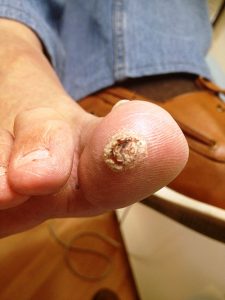More About Verrucae
What are they?
 Verrucae are plantar warts that commonly occur on the soles of the feet or around the toe area. They are caused by the Human Papilloma Virus (HPV) which is highly contagious through direct person to person contact. There are various forms of HPV which all relate to various parts of the human body.
Verrucae are plantar warts that commonly occur on the soles of the feet or around the toe area. They are caused by the Human Papilloma Virus (HPV) which is highly contagious through direct person to person contact. There are various forms of HPV which all relate to various parts of the human body.
What causes the problem?
The virus is thought to thrive in moist, damp environments such as swimming pools, changing room floors and communal shower areas. It is possible to contract verrucae simply by walking across the same floor area as someone with a verruca, especially if you have any small or invisible cuts or abrasions that make it easier for the virus to penetrate.
Is it serious?
Verrucae are harmless but can be uncomfortable and painful if they develop on a weight bearing part of the foot. In addition, callus can form over the top of the verruca increasing the discomfort in this area. There are also some strains of the virus that spread very quickly and can look unsightly.
Who gets them?
Verrucae are most commonly seen in children, teenagers and young adults, largely those who use communal changing rooms. It is possible to develop an immunity against the virus over time but most people remain susceptible, although some more than others.
Treatment
Verrucas are normally treated using acid based treatments available from your local pharmacy. However, if you feel you are not having any luck with these treatments, then you might want to consider Cryotherapy or Needling.
Cryotherapy involves freezing the verruca with nitrous oxide gas.
Needling is a “multiple puncture” technique carried out under a Local Anaesthetic.
Contact us now for an in-depth consultation regarding verrucae to help you decide which is the best treatment option.
Here are some images of "Before" and "After" somebody has had their verrucae frozen off. For this process to take place I needed to use the Cryopen and the results speak for themselves.



